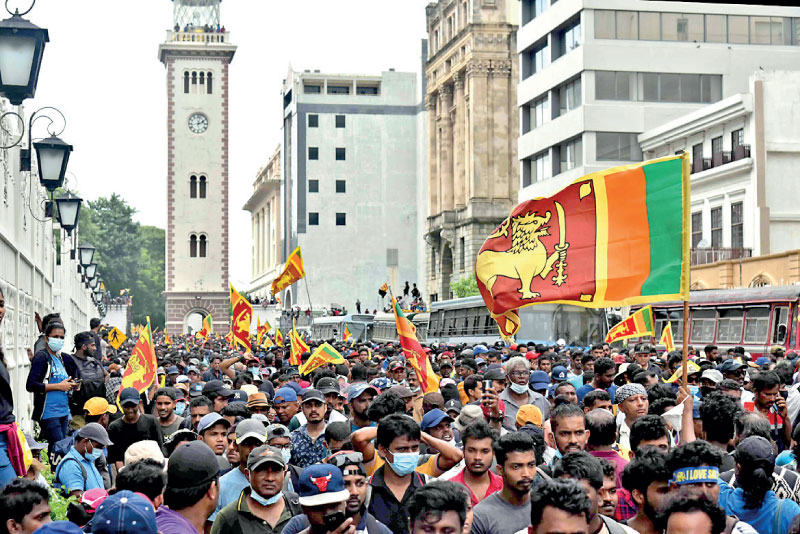Sunday Apr 20, 2025
Sunday Apr 20, 2025
Friday, 23 September 2022 02:39 - - {{hitsCtrl.values.hits}}

The Aragalaya had a sensitive heart, but it lacked a mature brain and intellectual prowess
 In what sense does the Aragalaya become important to us? What expectations has it generated? Has it been successful in achieving them? It can be considered as the biggest and the most popular uprising that erupted since Sri Lanka had entered the modern era. It was organised in a few days.
In what sense does the Aragalaya become important to us? What expectations has it generated? Has it been successful in achieving them? It can be considered as the biggest and the most popular uprising that erupted since Sri Lanka had entered the modern era. It was organised in a few days.
The Hartal of 1953 was an aggressive public uprising that took place in one day. It was smaller in size compared to the present Aragalaya. The Aragalaya has recorded the most active and maximum public participation on 9 July when President Gotabaya was compelled to flee the country. The number of people who came to Colombo city on that day to participate in the Aragalaya is said to be several millions, but my opinion is that it could have been between half a million to one million people. Although the struggle was not able to break the authority of the Rajapaksas completely, it was capable of demolishing the public recognition of the authority wielded by the Rajapaksas to a large extent.
Ranil’s advent to power was an incidental outcome of the Aragalaya and not something planned by it deliberately. Ranil’s arrival has not brought any positive change in the ugly look of the Government, but it was able to reverse the disastrous course of the Government which it followed up to then, and direct the country which was moving towards complete devastation to a path conducive to overcoming the crisis the country was facing. If the Opposition had adopted a policy of supporting Ranil at least on a short-term basis with the view to overcoming the crisis facing the country, undoubtedly, it would have been possible to bring about a positive change in the extent to which President Ranil has been compelled to depend on the Pohottuwa Party. However, it appears that the ambition of the official Opposition party has been to trap Ranil in the grip of the Pohottuwa and make him dependent on it.
Whose fault is it?
The Aragalaya can be considered as an outcome of the crisis; but it was not the solution to the crisis. Although the Aragalaya was initially prompted by the pressing issues such as rising commodity prices, gas and petrol queues gradually various oppressed social groups joined it transforming it into a struggle reflecting the extent of aggravation of the crisis in the social system. In a historic sense the Aragalaya can also be considered as a symbolic orchestration of a drum beat signalling the death knell of the old system and the old era. The Aragalaya had a sensitive heart, but it lacked a mature brain and intellectual prowess. The interpretation the Aragalaya has socialised about the causes of the crisis facing the country is not completely correct except partially.
Despite the fact that the Rajapaksas have caused a great deal of damage to the country, the crisis facing it cannot be considered as a consequence of the faults of them alone. For example, it is not only the Rajapaksas who have committed the mistakes like constructing museums at the expense of the Government to commemorate their parents; such mistakes have also been committed by the Presidents like Chandrika Kumaratunga, Ranasingha Premadasa and J.R. Jayewardene who were in power previously. Similarly, as far as the subject of illegal earning of wealth is concerned President Mahinda Rajapaksa may have amassed wealth which may be relatively greater than that of other presidents; but it can be said that all his predecessors too, have committed the same offense to a greater or lesser degree. Moreover, the crisis that Sri Lanka is facing now cannot be considered as one that is caused by the exploits and other serious mistakes committed by all those who fall into the category of politicians only. We must not forget that there are other reasons as well, for that.
Real reasons behind the failure
It is not only the wrongdoings of the ruling parties that have ruled the country for more than seven decades that have contributed to the bankruptcy and failure of Sri Lanka. The contribution made towards this situation by rebellious movements that had attempted to seize the ruling power by force several times is also huge. Prior to the ‘71 insurrection, the size of the Tri forces remained less than 7,000. Their service was used in official ceremonies and in disaster situations such as floods. At that time, the defence expenditure of the country also remained at a relatively low level. With the outbreak of violent rebellions, the size of the security forces has been increased by nearly 49 times and the corresponding defence expenditure of the country also increased to an extent that the country could not afford to bear.
According to a calculation made in 2002, the extent of damage caused to the country by ethnic riots and violent insurrections had been 200 billion dollars. Also, the rapid decline in export income for over 20 consecutive years has served as a factor that has aggravated the balance of payments problem Sri Lanka is facing. In the year 2000, the export income as a percentage of GDP stood at a significant level of 33.3. By 2018, it had dropped to 13.4%. The annual average export growth during 1977-2000 was about 10.7%, which fell down to 5.6% during the period 2000-2018.
The factors such as rampant corruption in institutions, evasion of tax by many organisations and individuals who are supposed to pay tax to the Government including the professionals, and employment of 1.5 million people in the public service that could be managed with 0.7 million employees, the enormous pressure inflicted on the government budget by state owned institutions that are continuously being run at a loss, can be said to have caused and aggravated this situation – the loss incurred by 20 major institutions such as Ceylon Electricity Board (CEB), Ceylon Petroleum Corporation (CEYPETCO), Sri Lankan Airlines (UL), Sri Lanka Transport Board (SLTB), National Water Supply and Drainage Board (NWSDB), etc. in last year alone has been Rs. 286,000 million, which amounts to Rs. 790 million a day.
Need for reaching a compromise acceptable to everyone
The current system of governance in Sri Lanka has been established in such a manner that it is not possible to overthrow the government in power at any other means than in an election. The attempt of the protesters of the Aragalaya to change the government without knowing this simple fact can be considered as the central issue that the proponents of the Aragalaya have got wrong or failed to realise. The ignorance of young strugglers of this fact is quite understandable; but how it is possible that the elderly scholars like university teachers, engineers, doctors and lawyers who supported the struggle were unaware of it?
It has been 233 years since the USA had adopted a presidential system of governance. During this long period of time, there has not been a single instance in which a President has been removed from power by any means other than in a presidential election or by an impeachment on a very rare occasion. Even in Sri Lanka, in the past 44 years, apart from Gotabaya, no other president has been expelled from office except during a presidential election or by assassination which was a rare occurrence. There can’t be a greater folly than fighting for an unachievable cause. Whatever is done must be done in a way that does not disrupt the program that has been put in place to resolve the balance of payments crisis. If it is missed, Sri Lanka will invariably end up in the backyard in the 19th century. There is no possibility of overthrowing or changing the government until an election is held.
At this special moment, for the common good of the country, what the all parties involved in the power struggle (the government, opposition political parties, those aspiring to launch new political movements and those involved in the Aragalaya) could do would be to join together on a reform program that will lead to a positive and profound change in the existing system which is corrupt and evil and implement it by creating a suitable democratic framework for that. If an early parliamentary election is required, it can also be included in the reform program.
Then the two phases of implementation of the proposed reform program could be linked and made into something that is closely related to each other (as was done in South Africa). Such a program will undoubtedly provide a solid foundation for resolving the balance of payments crisis. It will also provide a strong foundation for an early election and a positive and profound change in the system. Shouldn’t this be the path that the country must choose? Is there a better practical way out of the crisis? If so, what is it?